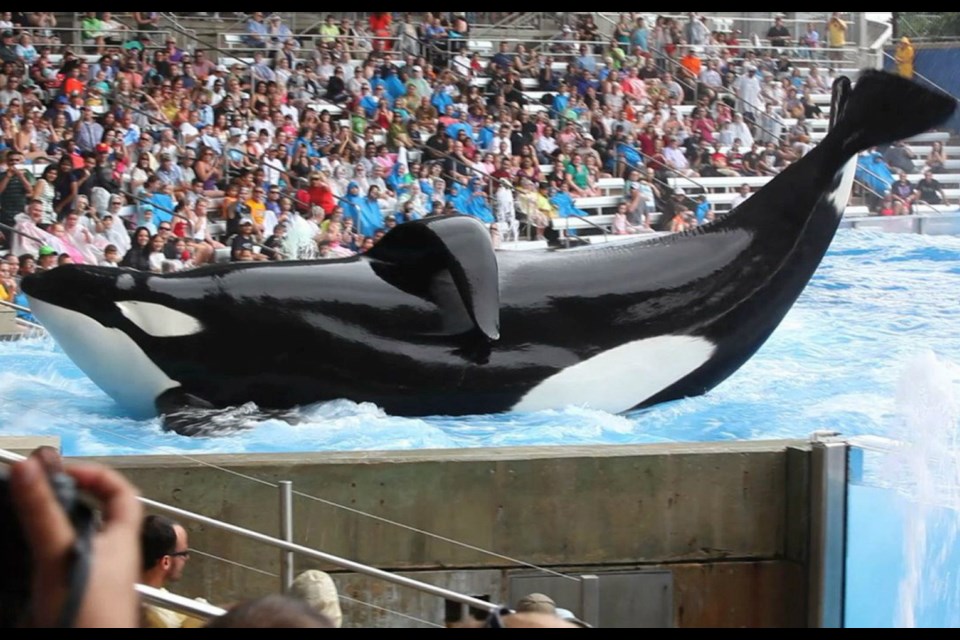It’s the stuff memories are made of — summer afternoons spent at Oak Bay’s Sealand of the Pacific where Tilikum was a star attraction in the late 1980s.
The beloved black mammal seemed eager to please as he splashed, frolicked and flew through the air on cue, coaxing smiles and applause from locals and tourists young and old until a 1991 tragedy foreshadowed his future.
That was when the 5,000-kilogram orca was involved in the death of Keltie Byrne, the Sealand trainer who drowned after falling into the pool with Tilikum, Haida and Nootka. Witnesses said the whales prevented Byrne from getting out of the pool.
Although the marine park closed in 1993, its star orca still performs at SeaWorld Orlando, where he was sent in 1992. It was big news when, in a shroud of darkness and secrecy in the wee hours of a cold January morning, Tilikum was hoisted by a crane into a cushioned tank on a flatbed truck, then loaded onto a Hercules transport plane for his flight to Florida.
Twenty years later, Tilikum is still making a splash, albeit in a darker vein. He’s front and centre in Blackfish, Gabriela Cowperthwaite’s documentary generating big buzz at the Sundance Film Festival, where it just made its world première.
Critics have been tripping over superlatives, some drawing comparisons to The Cove, Louie Psihoyos’s 2009 dolphin capture film, since seeing her documentary about the potentially devastating consequences of keeping killer whales in captivity.
Blackfish, for which Magnolia Pictures and CNN Films snapped up U.S. distribution rights, opens with horrifying video footage of Tilikum dragging experienced SeaWorld Orlando trainer Dawn Brancheau to her death in 2010.
It’s one of three deaths the notorious breeding bull has been involved with since his Sealand days. The other was an incident in July 1999 when a 27-year-old man died after entering SeaWorld’s orca tanks at night.
Blackfish isn’t cinematic character assassination of Tilikum; rather, it illustrates how such acts of aggression, backed up by commentary from experts, can result from the frustrations of being held in captivity. There have been 70 documented cases of orca attacks at marine parks, and Cowperthwaite says no one has been killed by an orca in the wild, only in captivity.
Her film explores a perplexing dichotomy — how such a sentient creature can at once be an endearing friendly giant, yet with the capacity to be a seemingly merciless killing machine. Blackfish blends shocking, previously unseen footage and interviews with experts and trainers, includng disillusioned sea park workers whose lives were endangered.
While Blackfish also explores the economics of the multimillion-dollar sea park industry, SeaWorld declined to participate.
“Why would a highly intelligent animal attack its trainer — in effect, bite the hand that feeds it?” Cowperthwaite asks. “I set out to understand this incident not as an activist, but as a mother [who had just taken her two kids to SeaWorld] and as a documentary filmmaker [who can’t let sleeping dogs lie].”
She began her film after reading an article on the Brancheau tragedy by Tim Zimmermann for Outside magazine. She was shocked and disturbed such an intelligent animal would turn on a human it presumably gets along with.
Cowperthwaite, who has also created projects for ESPN and the Discovery and History channels, was also inspired by Death at SeaWorld, David Kirby’s scientific thriller about the dark side of SeaWorld and the marine park industry.
“I wasn’t setting out to produce an exposé, but rather a film where every perspective would be presented to achieve a greater understanding of animals and their human caretakers,” notes Cowperthwaite, who said making her heart-wrenching film wasn’t easy. “There were nightmares, autopsy reports, sobbing interviewees and miserable animals.”
It wasn’t her intention to evoke particular emotions, she said — just to tell the story as truthfully and powerfully as possible.
Cowperthwaite is already learning that along with the accolades can come criticism.
“It’s par for the course,” says Suzanne Chisholm, the Gulf Islands filmmaker who experienced that herself with Saving Luna, the award-winning film she made with husband Michael Parfit about the endearing orca Luna.
They later created The Whale, their Hollywood “remake” narrated by Ryan Reynolds.
“Gabriela’s covering a very controversial story, and already there have been some nasty comments online,” Chisholm observes. “We had a few ourselves. Some people said people shouldn’t interact with whales [in the wild] and neither should we have.”
The most amusing criticism, Chisholm recalled, was being accused of exploiting ill-fated Luna’s story to get rich.
“That couldn’t be farther from the truth,” she said. “Nobody I know who makes independent films is in it for the money.”
If anyone can offer Cowperthwaite an idea of what lies ahead with a successful whale movie, it’s the couple who met her on San Juan Island at Superpod, an annual gathering of brainstorming orca enthusiasts, including former sea park trainers.
“This issue generates an enormous amount of emotion on both sides,” Chisholm said. “From a corporate point of view, I can’t imagine they [SeaWorld] will be happy. Given what we now know, the whales don’t really belong there anymore. It’s a hard pill to swallow. It’s an inconvenient truth.”
The couple, whose non-fiction book The Lost Whale will be published in June by Raincoast in Canada and St. Martin’s Press, were elated when they heard about Cowperthwaite’s Sundance success.
“She was so supportive,” Chisholm said. “We’re so happy for Gabriela and her crew. They’re good people and they’ve worked really hard on an important issue. It’s every filmmaker’s dream.”
